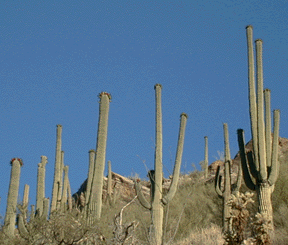 |
|
Saguaro Cactus
|
|
Some people think that saguaros look like soldiers standing at attention on the slopes of Sabino Canyon. I think they look more like ballet dancers striking poses. The wonderful thing about these dancers is that some have no arms at all while others have 1, 2, 3, or more arms. Saguaros come in all shapes and sizes.
The saguaro cactus is a unique plant. With its tall cylinder-shaped trunk and arms, it has become a symbol of the Southwest and of the Sonoran Desert, in particular. This cactus grows very slowly. In Tucson, it takes a saguaro about 10 years to grow 1 1/2 inches. In 30 years, it grows 2 feet. Many saguaros have nurse plants that protect them when they are growing. Saguaros develop arms when they are 50 to 100 years old. Some saguaros never grow arms at all; some have as many as 50 arms! A full-grown saguaro is 50 feet or more tall and weighs 6 to 7 tons when it if filled with water. It can live to be 200 years old. Saguaros have a tough, waxy outer skin that helps them keep moisture inside their trunks and arms. There are folds in this skin that expand and shrink depending on the amount of water they are storing. Water can make up between 75% and 90% of the weight. Like your skeleton, each saguaro has between 13 and 20 ribs that give it its shape and support. It also has spines to protect it from animals and to give the plant some shade. Most of the saguaro's roots grow less than 4 inches underground. These roots spread out in all directions. It also has a few roots that grow 2 to 3 feet deep. This root system helps it collect as much rain water as possible. Saguaros bloom when they are 8 to 10 feet tall. The saguaros' large, white, waxy flowers open in May and in June. They open at night and remain open only until the next afternoon. In less than 24 hours, the flowers must be pollinated so they can bear fruit. Nectar-feeding bats, like the lesser long-nose bat, pollinate most of the saguaros in Sabino Canyon. They are "primary pollinators" which means they are the main ones. If they leave any nectar or pollen, insects and birds will eat it. When insects and birds carry pollen to the next saguaro, then they become "secondary pollinators" for the saguaros. The saguaro's fruit is red. Each fruit contains 1,200 to 2,000 tiny black seeds, the size of poppy seeds. One saguaro may produce 40 million seeds in its lifetime. Only 1 out of 1,000 of those seeds will survive, one or two per fruit. There is a example of one unusual saguaro cactus near the *riparian* woodlands by Sabino Creek. It's called a cristate saguaro. The top of the cactus is shaped like fan. Some people think this saguaro looks like a camel. Saguaros come in many shapes. The Interesting Saguaro Page has a photo of the cristate saguaro and some other interesting saguaros found in Sabino Canyon. Saguaro Timeline
|
|
© 2001-2017 Judi Moreillon |





